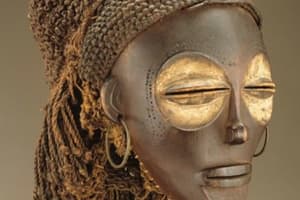Podcast
Questions and Answers
What is the primary difference in the treatment of iron during the African Iron Age compared to other cultures?
What is the primary difference in the treatment of iron during the African Iron Age compared to other cultures?
- Iron was used simultaneously with other metals. (correct)
- Iron was primarily used for weaponry and warfare.
- Iron was used exclusively after the Bronze Age ended.
- Iron was considered less valuable than gold.
Which material was predominantly used in the creation of ceremonial masks by the Dan people of present-day Ivory Coast?
Which material was predominantly used in the creation of ceremonial masks by the Dan people of present-day Ivory Coast?
- Clay
- Brass
- Wood (correct)
- Stone
What was the purpose of the Ndop sculptures created during the ancient Kuba Kingdom?
What was the purpose of the Ndop sculptures created during the ancient Kuba Kingdom?
- To serve as offerings to the ancestors.
- To represent the king and his personality. (correct)
- To mark important trade routes.
- To depict historical battles.
What is the earliest known example of traditional African stone art?
What is the earliest known example of traditional African stone art?
Which of the following statements best describes the role of masks in traditional African art?
Which of the following statements best describes the role of masks in traditional African art?
What civilization is specifically noted for their advanced iron smelting and creation of intricate art forms?
What civilization is specifically noted for their advanced iron smelting and creation of intricate art forms?
During which centuries did the Kingdom of Benin produce detailed bronze artworks?
During which centuries did the Kingdom of Benin produce detailed bronze artworks?
What aspect of Ife bronze art is highlighted as a distinguishing feature?
What aspect of Ife bronze art is highlighted as a distinguishing feature?
Which civilization is mentioned as using metal to represent various aspects of culture, society, and government?
Which civilization is mentioned as using metal to represent various aspects of culture, society, and government?
What type of artwork is considered essential for understanding historical information about Ancient African societies?
What type of artwork is considered essential for understanding historical information about Ancient African societies?
Flashcards are hidden until you start studying
Study Notes
Traditional African Art Overview
- Traditional African art utilizes diverse materials including stone, wood, clay, iron, brass, and gold, each reflecting the unique cultural practices of various communities.
- Key forms of traditional African art include masks, statues, paintings, and textiles.
Early Art and Stone Sculptures
- African stone art represents the earliest known form of traditional art; significant examples include the carving of giraffes from Dabous, Niger, dating back to 6,500 BCE.
Traditional Wooden Art
- Wood is commonly used to create expressive masks, figures, doors, and ornaments, especially in ceremonial contexts.
- Notable African ethnic groups, like the Dan of Ivory Coast, crafted solid wooden ceremonial masks embellished with precious materials such as gold, silver, and cowrie shells.
- Traditional wooden sculptures often mirrored the cultural significance of masks; important art flourished particularly in the Kuba Kingdom from the 17th to 19th centuries.
- The Kuba King, around 1700 CE, introduced the Ndop sculpture, symbolizing the king’s status and personality, with successors creating their own versions for legacy purposes.
Traditional Metallic Art
- Artisans used metals like gold, copper, and iron, with the Nok civilization (Nigeria and Benin) pioneering these practices and marking the onset of the African Iron Age around 1,500 BCE.
- Unlike other world regions, ancient Africa utilized iron and copper simultaneously, independent of a preceding Bronze Age.
- The process of smelting enabled the extraction of metals from ore, facilitating the creation of decorative masks and ornaments.
- The Igbo Ukwu civilization emerged as master iron smelters, producing intricately detailed masks, statues, and jewelry, which symbolize African heritage.
- The Kingdom of Benin (16th-17th centuries) is renowned for detailed bronze artwork, representing cultural themes through advanced metallurgy.
Yoruba and Ife Artistic Contributions
- The Yoruba civilization further advanced metallic artwork, depicting various cultural aspects through intricate metal representations.
- Ife bronze art is characterized by remarkable detail in facial features, depicting real-life scenes that serve as vital historical sources representing the daily lives of the people.
Studying That Suits You
Use AI to generate personalized quizzes and flashcards to suit your learning preferences.




